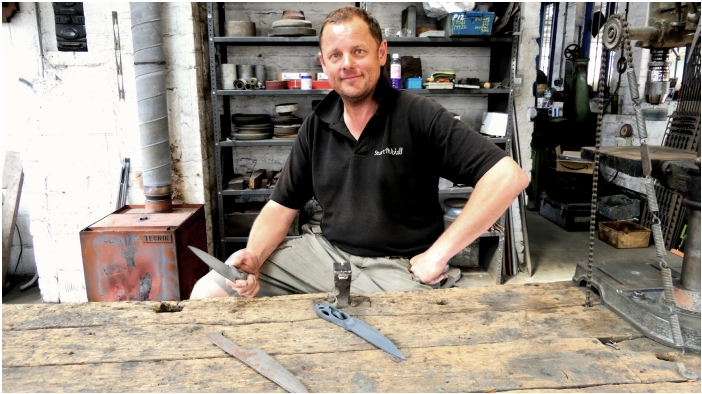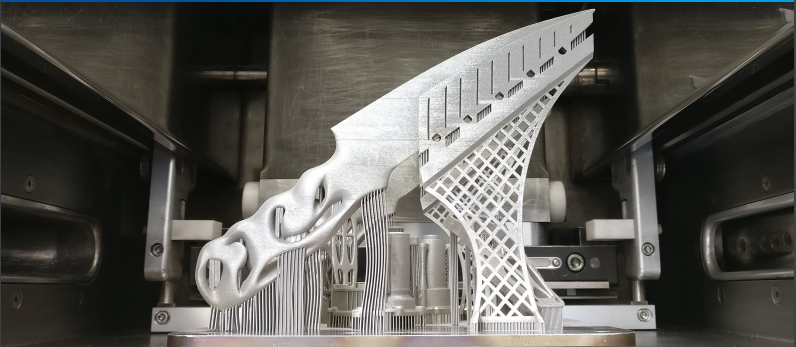Additive manufacturing stakeholders unite under GKN Aersopace £32M technology center
3D Printing News Sliced: Senvol, Betatype, Additive Industries, Hasso-Plattner Institute
Knife Maker Points to 3D Printing as Alternative Method of Craftsmanship
48-year-old Stuart Mitchell has been making knives for most of his life, learning from his father as a child and using many of the same tools his parents used in the workshop they acquired in 1980. In recent years, however, Mitchell began to explore alternative methods of crafting knives, which led him to additive manufacturing and a project he took on in partnership with the University of Sheffield’s Advanced Manufacturing Research Centre (AMRC).
“We were curious whether we could 3D print a viable chef’s knife using a titanium alloy,” said Andy Bell, Design Strategy Manager for the AMRC’s Design and Prototyping Group. “This is design led disruption in the truest sense of the word; a craft maker applying advanced manufacturing technologies and exploring how this could change their business model now and in the future.
“Design methods allow us to explore, through different frames, how we can approach a wicked problem like the introduction of additive manufacturing to an organisation who would never normally approach this technology due to the high perceived risk, cost and knowledge gap. We can use design to change perceptions by understanding the way in which small businesses work, their needs and wants, and then developing a response to this in a risk-free way.
“The project has been about understanding what the opportunity is. We provided Stuart with an AM blank which he would normally make himself from sheet metal, grind it and sharpen it up. The difference with what we’ve done is integrating the blade and the handle, which was moulded and customised to a chef’s hand. We then delivered the printed knives to Stuart for finishing.”
Engineers in the Design and Prototyping Group used several additive manufacturing build simulation packages to analyze the distortion of the knife using a standard support strategy. After analyzing all of the results, the engineers decided that a non-conventional support strategy could be applied to reduce distortion of the blade. They then used Simulation Utility for Netfabb to create the non-standard support structure that provided physical contact to the knife as well as non-contact thermal shrouding.
“Results delivered by the simulation package highlighted a likely reduction in distortion of the knife blade thanks to the thermal shroud support structure,” said Project Engineer Luke Hill. “The speed, ease of use, and multi-part simulation ability of Simulation Utility for Netfabb quickly gave confidence that both knives to be printed during the build would benefit from reduced blade distortion thanks to the novel support structure.”
The knife was 3D printed and delivered to Mitchell, who was impressed by its quality.
“I was impressed by the profile of the blade – it replicated very well what I would do by hand, particularly the taper from the spine to the edge,” he said. “It did need a degree of grinding to apply an actual cutting edge but the tolerances of the edge were good to start with, very fine. I didn’t realise it would print that fine. With the curvature and the detail in the handle, the hollowed out sections – I realistically can’t do any of that. It’s possible but not practical because there’s probably a week or more’s worth of hand work there. The fact that all that can be added or taken away, as it were, by changes to a CAD model and then adapted to suit – to increase or reduce weight – none of this I can do, it’s all very hands-on for me.
“Experience has given me a knowledge of the weight and balance of a handmade knife, what to expect and where to aim, there is also almost always a ‘suck it and see’ element though. I love the AM knife, it’s different and hasn’t been done before. Working in that very traditional way and to have something brand spanking new in the workshop is great – what’s not to like? What it perhaps also shows, particularly with all the advances in AM, is that there is still a place for what I do as well. An ideal product would perhaps marry the two.”
Mitchell connected with the AMRC through a friend, and took advantage of a grant funding scheme run by the AMRC to help small to medium enterprises fund research projects under the Catapult SME assistance scheme.
“I didn’t know a lot about AM and it was curiosity really,” said Mitchell. “A good friend and colleague of mine, Professor Peter Marsh from the University of Sheffield, was the mutual connection. He knows very well what I do and it was through his connections with the university and with the AMRC that the project came about. A couple of engineers from AMRC came to the workshop and I think because it’s such a different place here, that inspired the imagination that led to us doing this.
“The knife is designed around a chef’s hand from Freeman College, Chris Harrison. I made a version of the knife how I would make it and this AM knife comes from that, it is the next generation. A chef can come to me and I can mould his hand and create a knife which is very close to the AM knife but that’s it. There are bits then that I am restricted to do, the design features and different things. The limitations are that I am working by hand and the methods I use, which are the same as what my dad worked with when he was 15.
“The fact that working by hand doesn’t have the accuracy of AM is part of the charm for me. A glaring inaccuracy is just that, and unacceptable, but when you look at a handmade object in hand, whatever it is, and you’d need to very accurately measure it to identify any imprecision, when your eye cannot detect it, there lies the beauty of hand made for me. It’s practice over the years knowing what to look for.”
Mitchell first discovered 3D printing when he saw a 3D printed composite wrench, but it took him a while to come around to the idea of using 3D printing to make knives.
“What’s been restrictive up to now is all the materials that can be used to print – the polymers and such don’t really have anywhere that I can take it, even for a handle, because sometimes it can be quite brittle,” he said. “I think the thing I saw change, was the materials that became available. All of a sudden then, when we’re talking titanium, I started to think about how AM could work.
“Is it disruptive technology or does it enhance it? It’s about how you see something. I think it can enhance it. I don’t think it would be cost-effective for me to produce knives using AM but there might be aspects of that which could be married to aspects of what I do. Even if it’s a more traditional metal blade to an additively manufactured grip or handle – I think there is maybe space for both to be married together.”
Discuss this and other 3D printing topics at 3DPrintBoard.com or share your thoughts below.
[Source/Images: AMRC]



